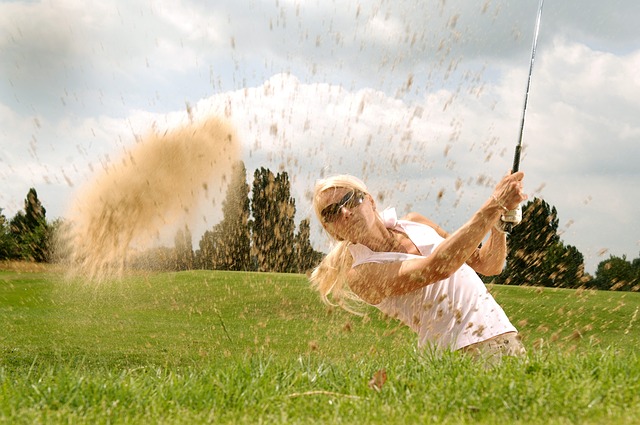Golf Tips From a Physical Therapist

The beautiful summer weather is drawing many people out to the golf course to enjoy the sunshine, fresh air, and exercise! Here are some tips and tricks from Catherine Johnston, PT, DPT to help you avoid injury and improve your game this season.
How can I prevent back pain?
Preparation is key. Before rushing out to play 18 holes, make sure you take the time to practice your swing mechanics and break down the components of the swing in half-speed (or even slower!) to reinforce good body mechanics. Many people want to go out and swing as hard as they can to get the distance they desire without paying attention to their body position. Remember: the golf club does the work of sending the ball down the green, your job is to safely get the club to the ball!
How should I grip my club to avoid injury, especially in the upper extremities?
There are many different golf gripping styles, and each comes with a certain variation of mechanics. This may impact the approach of the clubface and create disparities of the ball speed and direction. The main golf grip types are interlinking, overlapping, or baseball grips and typically once you find a style that is comfortable for you then you practice, practice, practice with that one style until your swing becomes more consistent.
After focusing on the grip, turn your attention to your elbows while you set up because this is key to aligning your body through the entirety of your swing. You want to avoid “chicken winging” by pointing your elbows directly at the corresponding hip, which brings your forearms rotated upwards towards the sky. Setting up with your arms forming a “V” increases the likelihood of you striking the ball straight on and not accidentally digging into the ground or injuring the arms and shoulders.
Do you really need to stretch before golf?
Absolutely! Golf is dynamic sport that requires coordination of a lot of moving parts. In order to optimize your performance and decrease risk of injury stretching is necessary before and even during your round. My tip: utilize the time you spend waiting to tee up to stretch your arms, legs, and back muscles to keep yourself limber throughout the entire course. Check out the video below for some simple stretches you can do right on the course.
How can physical therapy improve my golf game?
Physical therapy can help with the following:
- Strengthening your lower body and core to help increase your rotational power.
- Improving your range of motion in your upper body, back, and hips in order to go through an entire swing without compensation.
- Strengthening your lumbopelvic stabilizers to handle the acceleration and forces needed during a full trunk rotation.
- Stretching tight muscles in the arms and legs that are restricting motion.
- Assessing your swing biomechanics and giving insight to help with postural correction strategies to decrease risk of injury.
What are the most common golf related injuries that you treat?
- Back pain: muscle strains, disc bulge/herniation, facet dysfunction, stabilization weakness
- Tendinitis or inflammation in the elbows or wrists
- Shoulder pain or range of motion limitations: rotator cuff dysfunction or tears, impingement syndrome, arthritis/osteoarthritis
- Knee pain: sprained ligaments, meniscal tearing/fraying, arthritis/osteoarthritis, muscle strain
- Foot and ankle injuries: sprained ligaments, hypomobility, arch collapse, tendinitis/bursitis
- Hip dysfunction and pain: labral tears, muscle strains, bursitis/tendinitis
Call your local Sports & More Physical Therapy by ACCESS PT office today to schedule an evaluation. We’d love to help you feel your best as you get back on the course this spring!


